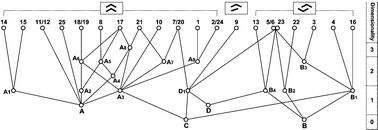Systematic investigation of the relationships between 25 crystal structures containing the carbamazepine molecule or a close analogue: a case study of the XPac method
Abstract
The concept of supramolecular constructs (CrystEngCom 2005, 7, 324) is used to compare 25 related crystal structures. This set is based on the carbamazepine (CBZ) molecule and contains four polymorphic modifications of CBZ, 19 multiple-component crystals and two close analogues of CBZ. Common zero- to three-dimensional structure fragments are identified and discussed. Two fragments of closely packed CBZ molecules, a stack and dimer, are identified as the dominating motifs. These are observed in 24 of the 25 structures. The close 2-D similarity relationship, based on the stack motif, between the triclinic and trigonal modifications CBZ is a particularily intriguing case. In contrast, the other two polymorphs of CBZ contain the dimer motif and they exhibit a 1-D similarity. This study demonstrates that the XPac method is a suitable method for the investigation of large sets of related crystal structures. A graphical method for the visualisation of complex similarity relationships is proposed. The results of this work highlight the great importance that the molecular shape plays in the assembly of molecules in the solid state even in such cases where hydrogen bonds are present.


 Please wait while we load your content...
Please wait while we load your content...